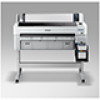Epson SureColor F6070 Network Guide - Page 11
How - drivers
 |
View all Epson SureColor F6070 manuals
Add to My Manuals
Save this manual to your list of manuals |
Page 11 highlights
How To Overview This section describes the general procedure on how to set up the network interface for use on a network. 1. Check the network interface operation. Check the functions and operations of the network interface, such as status lights and RJ-45 connector. See "Network Interface Operation" on page 8 for details. 2. Select a printing method. Select a printing method appropriate for your network environment and operating system. If you are not sure, see "Printing from Windows" on page 12 for details. 3. Install the necessary components on your computer. Make sure the necessary components (such as TCP/IP) are installed on the computer, and network settings (such as IP address, subnet mask, etc.) of the computer is set. See "About Installing Components on Your Computer" on page 13 for details. 4. Connect the network interface to the network. Connect the network interface to the network. See "Connecting the Network Interface to the Network" on page 16 for details. 5. Configure the network interface and install the printer driver. See "Configuring the Network Interface" on page 17 or "Installing the Printer Driver" on page 17 for details. 6. If necessary, configure the network settings of the network interface using EpsonNet Config. Configure the network interface for TCP/IP, AppleTalk, etc. using EpsonNet Config. For Windows users, see "About EpsonNet Config" on page 26. How To 11















